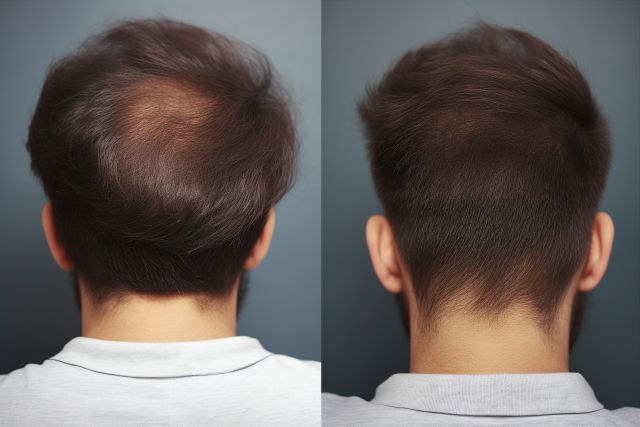Before looking into the details of Rogaine vs. hair transplants, it is important to understand that Rogaine is a manufacturer’s trade name for minoxidil. Secondarily, there are different types of hair loss with different underlying causes, so in the world of hair restoration, there is no “one-size-fits-all” solution.

Hair loss, whether male or female, can occur due to a wide variety of factors and causes. The most prevalent cause is genetic or hereditary hair loss. Secondary causes of balding and hair loss in men and women include hormonal changes, medication, stress (telogen effluvium), and certain medical conditions and their related treatments. Before pursuing any hair loss treatment plan, it is absolutely mandatory to identify the actual underlying cause of the hair loss and to determine the most suitable treatment approach based on that determination.
Hereditary Hair Loss in Men & Women
Hereditary hair loss, also known as androgenetic alopecia, is the most common type of hair loss in both men and women. It is caused by a combination of genetic and hormonal factors and typically follows a predictable pattern. Men often experience a receding hairline and thinning crown, while women may notice overall hair thinning.
Other Causes of Hair Loss
Hair loss can also be attributed to factors such as medication side effects, stress, nutritional deficiencies, autoimmune conditions, and certain medical treatments like chemotherapy. Identifying the specific cause of hair loss is crucial in determining the most effective treatment strategy.
Minoxidil as a Hair Loss Treatment
Minoxidil is a widely used medication for treating hair loss. It is marketed under several trade names, the most well-known of which is Rogaine. It is available in both oral and topical forms. When used topically, minoxidil is applied directly to the scalp, where it works by increasing blood flow to the hair follicles and stimulating hair growth. Other hair loss treatments include Platelet Rich Fibrin (PRF) hair therapy treatment as well as laser hair therapy. Let’s take a closer look at the applications and effectiveness of minoxidil.
Topical Minoxidil for Male Pattern Baldness
Topical minoxidil is commonly used to treat male pattern baldness, also known as androgenetic alopecia. It is available over the counter and can be easily incorporated into a daily hair care routine. Minoxidil is believed to extend the growth phase of the hair follicles, promoting thicker and longer hair growth.
Topical Minoxidil for Female Pattern Hair Loss
Women experiencing hair loss can also benefit from topical minoxidil. Female pattern hair loss often manifests as overall hair thinning, and minoxidil can help slow down the progression of hair loss and stimulate new hair growth. It is important to follow the recommended usage guidelines and consult a healthcare professional for personalized advice.
Effectiveness of Minoxidil
The effectiveness of minoxidil (Rogaine) varies from person to person. Clinical studies have shown that minoxidil can stimulate hair regrowth in a significant percentage of individuals. However, results may take several months to become noticeable, and consistent, long-term use is required to maintain the benefits. It is therefore important to set realistic expectations and understand that minoxidil may not work for everyone, and that if you do choose to use it, you can reasonably expect to need to use it for the rest of your life.
Hair Transplant Effectiveness
Hair transplant procedures offer a surgical solution for individuals seeking more permanent results. These procedures involve the transplantation of hair follicles from the donor area (typically the back of the scalp) to the recipient area where hair loss is occurring. There are two primary types of hair transplant procedures in use worldwide today: follicular unit transplantation (FUT) and follicular unit extraction (FUE).
Follicular Unit Transplantation (FUT)
Follicular Unit Transplantation (FUT) is a traditional hair transplant technique. It involves harvesting a strip of scalp from the donor area and then dissecting it into individual follicular units under a microscope. The hair follicles are then transplanted into the recipient area, where they will continue to grow naturally.
Follicular Unit Extraction (FUE)
Follicular Unit Extraction (FUE) hair transplantation is a more advanced and minimally invasive hair transplant technique. Instead of removing a strip of scalp, individual hair follicles are extracted directly from the donor area using a specialized punch tool. These follicles are then implanted into the recipient area, resulting in a natural-looking hairline which will continue to grow for the rest of the patient’s lifetime.
Hair Transplants are Not for Everyone
One of the significant advantages of hair transplant procedures is their permanent nature. The transplanted hair follicles are resistant to the hormone responsible for hair loss, ensuring long-lasting results. However, it’s important to note that hair transplant procedures require careful planning, skilled execution, and a comprehensive aftercare routine for optimal hair transplant results and outcomes.
While surgical hair transplantation offers a permanent solution to hair loss and balding, not everyone is a suitable candidate for a hair transplant procedure. Factors such as the extent of hair loss, the availability of an adequate supply of transplantable hair in the patient’s donor area, and the patient’s overall health play a significant role in determining a person’s candidacy for hair transplantation.
Deciding between minoxidil and a hair transplant can be challenging. It’s crucial to consider factors such as the underlying cause of hair loss, the extent of hair loss, personal preferences, and budgetary constraints. Consulting with a qualified hair transplant specialist with a proven track record is essential to assess candidacy and determine the most appropriate treatment plan.
Minoxidil vs Hair Transplant Surgery
Minoxidil is an accessible and non-invasive option for individuals experiencing early-stage hair loss or those who prefer a conservative approach before considering a surgical solution. It is relatively affordable and can be easily incorporated into a daily hair care routine. However, it requires very long term and consistent use and may not provide the same permanent results as a hair transplant.
Hair transplants, on the other hand, offer a much more permanent solution to hair loss and can provide natural-looking results. They are particularly beneficial for individuals with advanced hair loss or those seeking a significant improvement in hair density. However, hair transplant procedures are surgical interventions that require careful consideration, planning, and a commitment to post-operative care lasting generally up to one year.
Finding the Right Solution for Hair Loss
Hair loss can be a distressing experience, but there are effective solutions available. Minoxidil and hair transplants offer different approaches to combating hair loss, each with its own benefits and considerations. Understanding the underlying cause of hair loss, consulting with specialists, and setting realistic expectations are crucial steps in finding the right solution for you. Whether you opt for minoxidil or a hair transplant, taking proactive measures to address hair loss can restore confidence and help you regain control over your appearance.
If you are considering coming to St. Louis for a hair restoration procedure, we invite you to contact our clinic today to schedule a free, private consultation with our experienced surgeons. We will work one-on-one with you and answer all your questions so that you can choose the most suitable method for your hair restoration journey.
Disclaimer: The information provided in this article is for informational purposes only and should not be considered as medical advice. Please consult with a qualified healthcare professional for personalized advice and treatment options.





